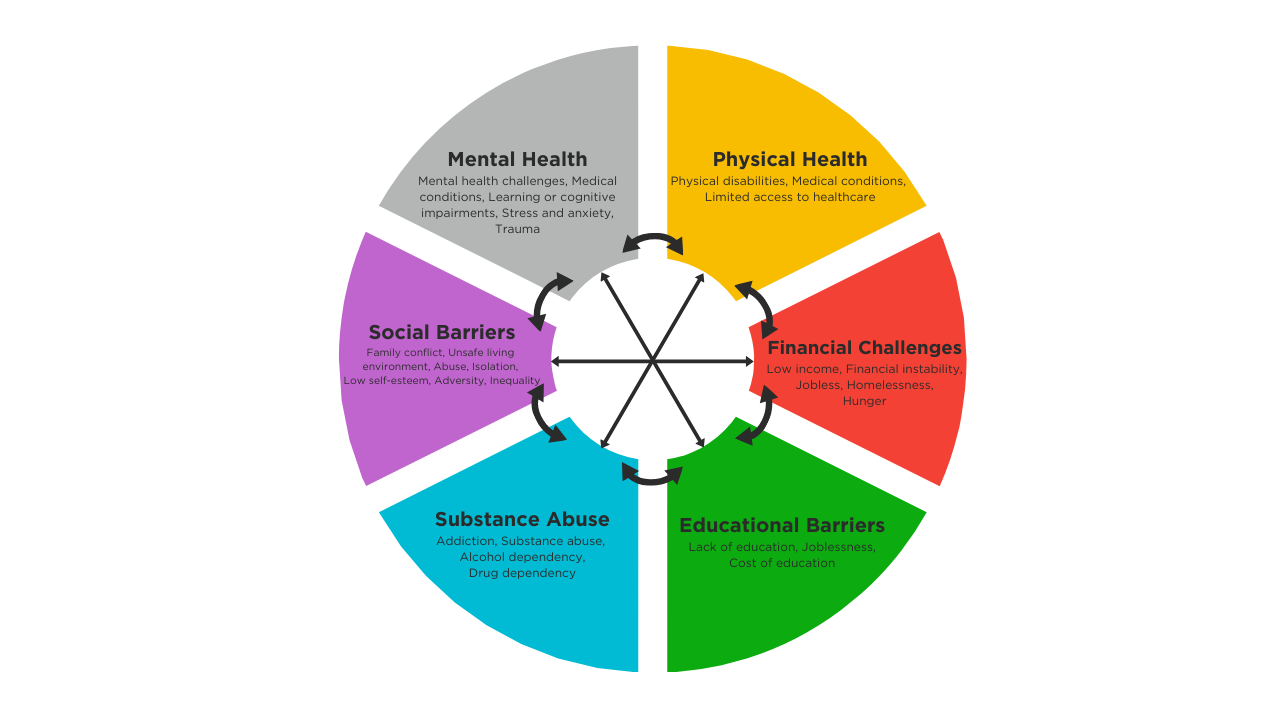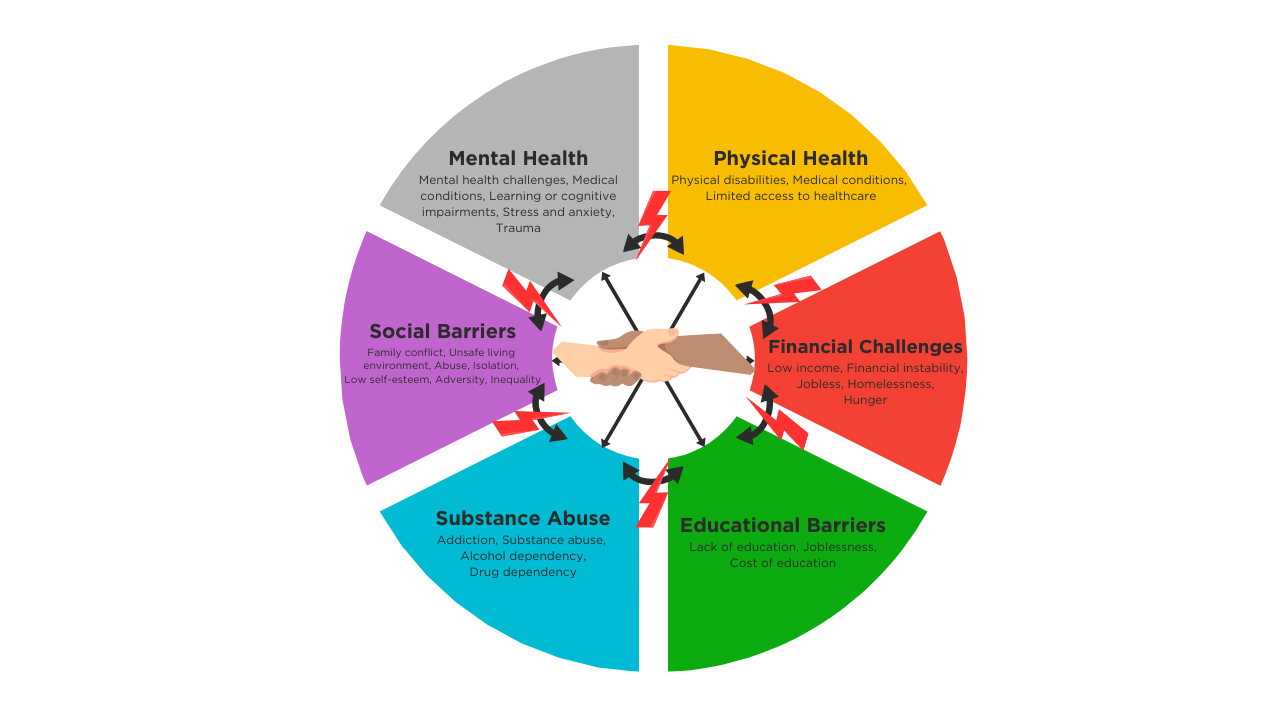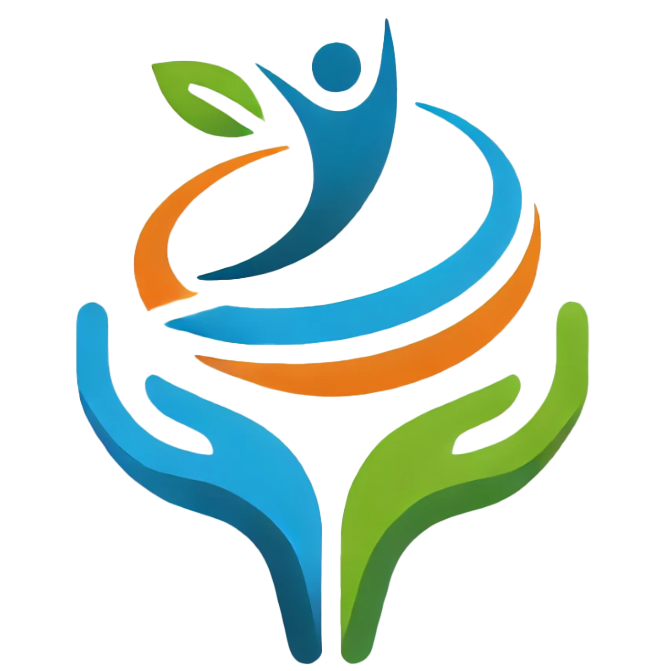
The interconnectedness of financial challenges, educational barriers, substance abuse, social factors, mental health, and physical health plays a significant role in perpetuating the poverty cycle. Let’s explore how these factors intersect:
- Financial Challenges:
- Poverty often results from limited financial resources, making it difficult for individuals to access quality education, healthcare, and other essential services.
- Financial instability can lead to stress, anxiety, and depression: affecting mental health.
- Educational Barriers:
- Poverty can hinder educational attainment due to inadequate resources, and lack of access to quality programs.
- Lower educational levels limit job opportunities, perpetuating financial struggles.
- Substance Abuse:
- Poverty increases the risk of substance abuse due to stress, trauma, and lack of coping mechanisms.
- Substance abuse further exacerbates financial instability and negatively impacts mental and physical health.
- Social Barriers:
- Stigma, discrimination (race, color, national origin, marital status, age or disability etc.) and social isolation are common in impoverished communities.
- These barriers affect mental well-being, limit access to resources, and hinder social mobility.
- Mental Health:
- Poor mental health is associated with poverty, as stressors and adverse life events contribute to mental health disorders.
- Mental health issues can impair educational and work performance, perpetuating poverty.
- Physical Health:
- Poverty often leads to inadequate nutrition, limited access to healthcare, and unhealthy living conditions.
- Chronic physical health conditions can impact productivity and financial stability.
Interconnected Impact
These factors reinforce each other: poor mental health affects educational outcomes, substance abuse worsens financial stability, and social barriers perpetuate poverty. The diagram clearly shows how the ‘vicious cycle’ is made up of overlapping elements, which all impact each other and make escaping poverty more and more difficult over generations.
Poverty Cycle of Maria’s family
This is Maria’s experience of intergenerational poverty in a family. This case reflects the harsh reality faced by many families.

Maria’s father passed away when she was just six years old, leaving her mother Rosa to work two jobs as a cleaner to barely make ends meet.
From a young age, Maria accompanied her mother to clean houses after school and on weekends since no one looked after her at home. Bright and hardworking, Maria learned the value of perseverance. However, when she turned sixteen, Rosa fell ill and could no longer work as much. Maria took on the responsibility of caring for her mother, which began to affect her schoolwork. Her slipping grades were misinterpreted as laziness by her teachers, and Maria, feeling discriminated against as a child in poverty, did not speak up and seek help. Although Rosa received welfare cheques and Maria worked part-time cleaning residential houses, they could not keep up with the rent and essential needs. They became trapped in a cycle of debt, exacerbated by payday loans. So they moved to a very cheap and bad neighbourhood where substance use disorders were common.
After Rosa passed away, Maria was left alone with debt, anxiety, and depression. Her friends introduced her to drugs and alcohol as an escape. Eventually, Maria developed substance use disorders and as a result, she was no longer able to pay rent. During her time of homelessness, she gave birth to a baby boy with alcohol & drug-related birth defects. The social services took the baby away from her due to the unsafe environment. Remembering her mother’s hard work and love for Maria, Maria entered a detox and rehab program to regain custody of her child. However, her son’s disability was permanent, limiting his educational and employment opportunities, and perpetuating the cycle of poverty. Despite the seemingly infallible trap, the cycle of poverty can be broken through interventions.
Interventions to Break the Poverty Cycle
Breaking the poverty cycle requires a holistic and multi-faceted approach. Addressing the diverse and interconnected barriers individuals face is essential for fostering lasting change and creating opportunities for upward mobility.

Breaking the Poverty Cycle of Maria’s Family
We see Rosa and Maria had difficulty coping with hard situations and could have benefitted from additional support and resources to prevent Maria from homelessness.

Financial Stability One of the primary steps in breaking the poverty cycle is enhancing financial stability. This involves creating jobs, providing affordable housing, and ensuring food security. Job creation programs help individuals gain stable employment, while affordable housing reduces homelessness and provides a safe living environment. Food security projects like food banks and community meals ensure access to nutritious meals, help to alleviate hunger and improve overall health.
- Connecting Rosa with programs for single mothers could have provided her with more affordable housing, childcare, and meals. Additionally, Rosa might have qualified for training to secure a stable job, allowing Maria to focus on her education.
Education and Skill Development Education is a powerful tool in breaking the poverty cycle. By improving access to education, scholarships, vocational training, and mentorship programs, individuals can acquire the skills and knowledge needed to secure stable employment. Investing in education not only benefits individuals but also strengthens communities with a more skilled and capable workforce.
- Education could lead Rosa and Maria to a bright future. Rosa could have benefited from paid education training, which might have alleviated some of her stress and prevented her from falling ill.
Substance Use Disorders Rehabilitation Addressing substance use through rehabilitation programs and support services is essential in helping individuals break free from addiction. By providing the necessary support and resources, individuals can overcome addiction and regain control of their lives.
Providing preventive education about substance use dangers to Maria and her friends might have spared her from falling into addiction.
Social Support and Community Development Creating safe and supportive environments is key to helping individuals overcome social barriers. Communities such as Vancouver’s Neighborhood House, or community youth groups/afterschool care that promote social equality, provide counselling services, and foster community engagement can create a sense of belonging and support.
- Rosa would have received guidance from the social workers at the Neighborhood House through the community programs. At the same time, Maria would have received support from the leaders when attending the community after-school care or the youth groups.
Mental Health Support Mental health challenges are a significant barrier in the poverty cycle. Providing access to mental health services, counselling, and treatment can help individuals manage and overcome these challenges. Promoting mental well-being and addressing mental health issues is essential for individuals to escape the cycle of poverty and improve their life quality.
- After Maria’s father passed away, both Maria and Rosa probably encountered mental health difficulties. Rosa would have benefited from mental health support services to help her adjust to life as a newly single mother. Similarly, after Rosa’s death, Maria could have also benefited from services to cope with grief and potentially prevent substance use.
Healthcare Access Providing affordable and accessible healthcare, mental health support, and rehabilitation programs can help individuals manage and overcome health-related barriers. Preventive care and health education can also reduce the long-term impact of health issues and substance use disorders on impoverished communities.
- Had Rosa and Maria had access to preventive health care, Rosa might not have succumbed to her illness, and both could have been connected with mental health and social support resources.
In conclusion, by addressing these financial, educational, substance abuse, social, mental health, and physical health barriers through comprehensive strategies and targeted support, we can empower individuals and families to overcome these challenges, fostering a future where everyone can thrive. This approach underscores the importance of understanding and addressing the root causes of poverty, rather than merely treating its symptoms.
